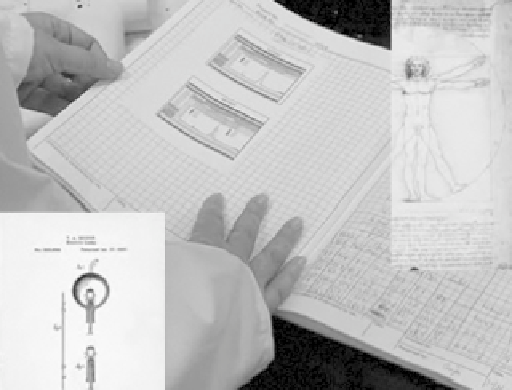Biomedical Engineering Reference
In-Depth Information
Figure 19.1
Paper laboratory notebooks: past and present.
largest collection made up from 12 volumes and over 1100 pages is the Codex
Atlanticus [2]. The Royal Institution (London) also has notebooks from Sir
Humphrey Davy and Michael Faraday in its archives [3]. These notebooks
were essentially personal productivity tools that recorded experimental pro-
cedures, the results, and related observations. Subsequent experiments were
then designed based on the scientist's knowledge and intuition. Their use
expanded to include intellectual property (IP) protection in countries, like the
United States, that issued patents on a fi rst-to-invent basis. In such areas rules
evolved around laboratory notebook records to substantiate the fi rst to invent
claim. It is not suffi cient to record an idea to claim an invention. Due diligence
must be followed in reduction to practice; that is, the idea must be converted
to an actual work product in a reasonable time. A combination of conservatism
and a lack of case law concerning the admissibility of electronic records in U.S.
courts retarded the adoption of electronic laboratory notebooks (ELNs) even
as research became increasingly electronic.
The U.S. Patent and Trademark Offi ce (USPTO) issued an Offi cial Gazette
notice on March 10, 1998, relating to the use of electronic records in patent
interferences that asserted that, pursuant to 37 Code of Federal Regulations
(CFR) 1.671, electronic records are admissible as evidence in interferences
before the Board of Patent Appeals and Interferences to the same extent that
electronic records are admissible under the Federal Rules of Evidence (FRE)
[4]. This paved the way for the acceptance of electronic records, but it was not
tested until 2002 in RE: JOLLEY, 01-1646 (U.S. Federal Circuit 2002) [5]. In
this case an e-mail sent from one coinventor to another was deemed to contain
the conception of an invention and the priority date for the invention was set
as the date of the e-mail
In countries where patents are issued on a fi rst - to - fi le basis notebooks
served the original purpose of personal record archive, but in countries such

Search WWH ::

Custom Search